Your cart is currently empty!
What is Earthenware Made of? – Earthenware Pottery 101
Published:
Last Updated:
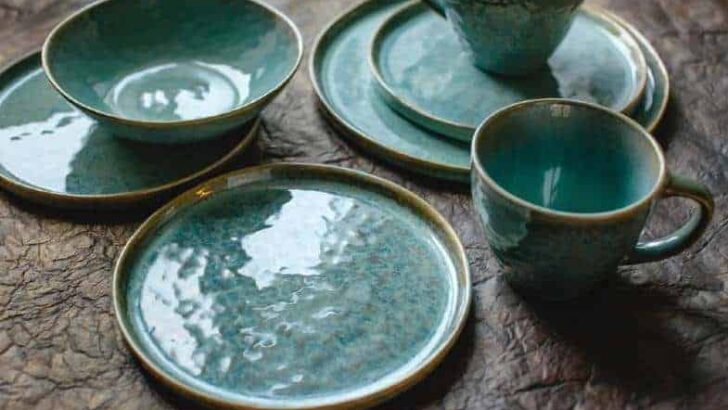
Affiliate Disclaimer
As an affiliate, we may earn a commission from qualifying purchases. We get commissions for purchases made through links on this website from Amazon and other third parties.
Earthenware pottery is everywhere. It is used to make everything from roof tiles, building bricks, plant pots, and dinnerware. So, what is this amazingly versatile material called earthenware? And exactly what is earthenware made of? Here is your answer in a nutshell:
Earthenware is traditionally made from ‘red earthenware’ clay or ‘red terra-cotta’. However, some earthenware clays are buff, grey, or white. Earthenware pottery is usually fired below 2012F (1100C). When fired, the ceramic body is porous and often glazed to make it waterproof. Earthenware glazes tend to be brightly colored but soft.
But let’s look a little deeper and take a closer look at the question of what earthenware is made of…
Simply put, earthenware is pottery that is made from earthenware clay. Earthenware clay is usually fired up to temperatures between 900 and 1100C.
Firing clay refers to the process of baking the clay at high temperatures in a pottery kiln. And a kiln is an insulated heating chamber designed to reach the right temperatures to turn clay into hard ceramic.
From an everyday point of view, 900-1100C is extremely hot. However, in the ceramic world, this temperature range is referred to as the ‘low fire’ range. This means that compared to other kinds of pottery, earthenware is fired at quite low temperatures.
The other types of pottery in question are stoneware and porcelain pottery. Each of these can be fired at higher temperatures than earthenware.
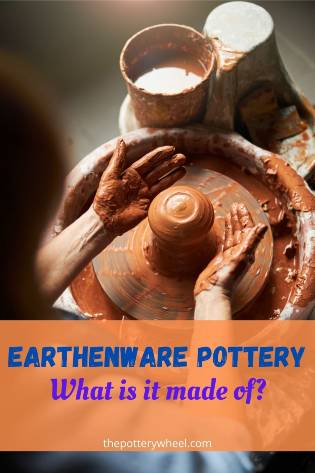
The Importance of Firing Temperatures
You may be wondering what the firing temperature of clay makes. Well, as clay is fired it undergoes a lot of changes. These changes are physical, chemical, and mechanical. During firing, the clay is transformed forever from being soluble clay, into hard, insoluble ceramic matter.
All clay, whether it is earthenware, stoneware or porcelain goes through the ceramic change. However, clay goes through other changes too, and these changes happen at different temperatures.
Earthenware Pottery and Vitrification
One of the key differences between earthenware and stoneware or porcelain is something called vitrification. Clay contains glass-forming ingredients. One of these ingredients is silica. When silica gets hot enough, it melts and forms liquid glass. As it cools, it becomes solid again.
When clay is fired to a high enough temperature, the glass-forming materials form a liquid glass in the ceramic. This glass fills up the gaps between clay particles. At the end of the firing process, as the pottery cools, the glass between the clay particles becomes solid again.
The solid glass blocks up the pores in the ceramic and prevents the pottery from absorbing water. As a result, the pottery has become non-porous. This is the process of vitrification. And it takes place at temperatures higher than those used to fire earthenware pottery. This is why some pottery is referred to as vitreous, and other is called non-vitreous.
It’s worth stressing that vitrification is a process. If earthenware is fired up to 1100C then the process of vitrification will have started. So, there will have been some glass formation in the clay. However, it won’t be enough for the pottery to be fully vitrified. Another term used to refer to vitrified pottery is to say that it has reached maturity.
Nevertheless, earthenware clay lacks enough of the glass-forming ingredients to become fully vitrified. So, even if it was fired to a higher temperature, it would not mature in the same way as stoneware.
Characteristics of Earthenware
Earthenware pottery has some distinct characteristics. These are as follows:
Porosity
Earthenware clay is low-fire clay, and it is not fired up to a temperature where it becomes vitrified. As a result, earthenware pottery is made of porous ceramic material. Once fired earthenware clay stills absorb moisture because the pores in the clay have not been filled up by glass.
This contrasts with stoneware or porcelain clay that have been fired to maturity. Both these types of clay are vitrified when mature and non-porous.
Softness
Another feature of earthenware pottery is that it is quite soft. In the ceramic world the terms soft, medium, and hard, refer to firing temperatures. Low temperatures of 1112F-1922F (600-1050C) are ‘soft temperatures’. Whereas the temperature range of 2102-2552F (1200-1440C) is known as ‘hard temperatures’. (source)
But, earthenware pottery is soft in the ‘normal’ sense of the word too. Of course, once it’s been fired, the clay is turned into hard ceramic material. However, earthenware is more porous and less dense than stoneware or porcelain. As a result, it’s more prone to chipping or breaking in everyday use.
Glazing Pottery
Firing pottery usually takes place in two stages. The first firing is the bisque fire. It is during the first firing that the clay is transformed into ceramic material. It’s easy to remember this because, in the first fire, the clay is converted into bisque or ‘biscuit’ ware. Think about turning soft cookie dough into a hard crunchy biscuit.
All clay types are usually fired in the same lower temperature range during the bisque fire. And all clay is porous after the bisque fire. Regardless of whether it’s earthenware, stoneware, or porcelain.
The difference in firing temperatures is more important in the second stage of firing clay. This is called the glaze fire. After the bisque fire, the pottery is painted with a liquid that contains powdered glass suspended in water. This is called glaze. Glaze contains other ingredients too, but for simplicity, it’s helpful to think of glaze powdered glass in water.
When the glaze is fired a second time, it melts in the kiln and covers the pottery in a glassy layer. When the pottery cools, this layer becomes solid and creates a waterproof coating on the pottery. Glazing is one of the ways that pottery becomes non-porous.
Earthenware Glazes
Glazing is particularly important to earthenware pottery because it is the main way that it is made waterproof. When stoneware or porcelain clay vitrifies, the clay itself becomes non-porous. Earthenware pottery is made from clay that does not fully vitrify. So, it needs to be glazed if it’s going to become waterproof.
Earthenware glazes are soft in the ceramic sense of the word. Meaning that they are fired at lower temperatures. But they’re soft in the everyday sense of the word meaning that they scratch more easily than high-fire glazes.
Nevertheless, earthenware glazes are known for having a range of bright, vibrant colors. This is partly because the colorants added to glazes do not get burnt out at lower earthenware temperatures. They are also known for having an attractive high shine.
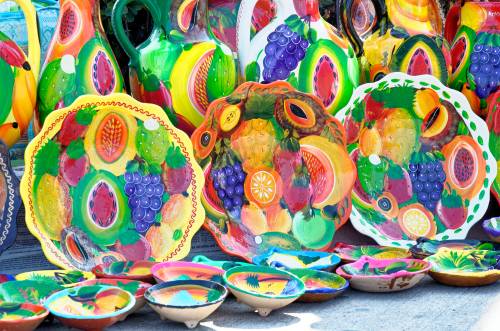
Another key difference between earthenware and high-fire clays is called the ‘body-glaze’ layer. When pottery is fired in a higher temperature range, the clay body itself starts to melt. The molten clay body mingles with the molten glaze. When the pot cools, this mingled layer becomes solid and creates a firm bond between the clay and the glaze.
Earthenware clay isn’t fired to temperatures high enough where the clay starts to melt significantly. So, whilst the glaze melts and forms a glassy surface on the pot, a body-glaze layer is not formed. This means the glaze sits on the surface of the pot, rather than becoming part of the ceramic material.
The absence of a body-glaze layer is another reason why earthenware glaze is not as tough as high fire glazes.
Why is Earthenware Pottery Low Fire?
There are two main reasons why earthenware is low fire:
Reason 1:
The first reason is that earthenware is one of the oldest forms of ceramic ware. Earthenware pottery was being produced by potters many years before the introduction of stoneware or porcelain.
Potters have been making earthenware pottery for thousands of years. In the past potters were unable to reach the kinds of very high temperatures that can be achieved today in modern kilns.
Kilns with a more primitive design would typically fire up to temperatures of around 800C. This is hot enough to convert clay into ceramic material. However, it is not hot enough to mature stoneware or porcelain clay to the point of vitrification.
A lot of the vintage earthenware pottery that exists today was made before very high firing temperatures were easily achieved.
Reason 2:
The second reason is related to the type of clay that earthenware is made of. Earthenware does not cope with being fired at the higher temperatures used for stoneware and porcelain.
If earthenware clay is fired at too high a temperature it can become bloated, or shatter. Alternatively, it will become very dense, brittle, and not fit for purpose.
Clay is made up of minerals, and different types of clay contain different types of minerals in different quantities. This is why different clays behave differently at various temperatures. Let’s take a closer look at the minerals that make up earthenware pottery…
Earthenware is Made of Secondary Clay
Earthenware clay is known as a secondary clay. Pottery clay is mined from the earth and taken to processing plants to be refined before it’s sold.
Like most mined substances, pottery clay takes thousands of years to form in the earth. It starts its journey as sediment that is worn away from rock formations by the wind and rain.
Sometimes this sediment stays where it is originally deposited and forms clay at that site. This is known as primary clay. However, most of the time the sediment is transported by water or wind to other sites and forms clay there. These clays are called secondary clays.
Two important things happen to the sediment as it is transported. The first is that the particles are often ground into smaller sizes on their journey. The second thing is that the clay sediment picks up other minerals and contaminants on the way.
Earthenware clay is made of fine particles due to the process of being transported. These fine particles make earthenware very plastic. Plasticity is a name given to clay that is easy to work, shape and mold.
The journey to its secondary site is also the reason that much earthenware is red. Red earthenware and terracotta pick up iron oxide on their journey, which gives it a rusty color.
Ingredients and Recipes
But of course, not all earthenware is red, some are buff, grey, brown, or white. The exact appearance and qualities of the clay will depend upon its ingredients. Although clay is mined, it is also processed. And commercially available clay is made up of different ingredients.
Some potters will mix and combine their own earthenware clay. Here is an example of a recipe for red earthenware throwing clay. It is one of a number of recipes produced by Alfred Clay Bodies.
| Ingredients | Quantities |
| Redart Om #4 (ball clay) Wollastonite Pyrax Frit 3195 Bentonite | 62.5 5 5 5 3.3 2.6 |
As well as being made of different types of clay, earthenware pottery comes in different styles. When asking the question, what is earthenware made of, it’s important to consider what these different styles are. That is what we will look at in this next section.
Different Styles of Earthenware Pottery
Earthenware pottery is an umbrella term that refers to a wide number of styles of pottery. Here are just a few of these different styles:
Slipware
This is earthenware pottery that has been decorated with colored slips. Slip is liquid clay that can be used to add color and texture to pottery. The pot is then coated with a transparent glaze. In the past this transparent glaze usually contained lead.
Slipware initially started being made in rural America and Europe. However, its production was at its peak in Staffordshire in the UK in the 17th and 18th centuries. As a result, it’s become known as Staffordshire or English slipware.
It was often thrown on the wheel or sometimes made by pressing the clay using a mold. The clay used was often buff or red. And it was decorated using slip that had been colored by oxides, such as copper, manganese, or iron.
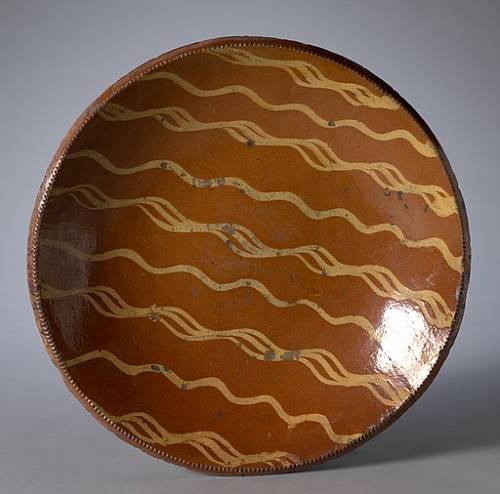
Maiolica
Maiolica is tin-glazed earthenware pottery. Tin glaze is a plain lead glaze, to which has been added some tin oxide. The tin oxide makes the glaze an opaque white color.
Maiolica pottery is bisque fired then the glaze is applied. Decorations are then painted onto the unfired glaze using metal oxides. When the pieces are glaze fired, the decorations sink into the molten glaze and become part of the glaze design. This is known as inglazing.
Maiolica ware originated from the Mediterranean. Many areas in the Mediterranean produced tin-glazed pottery. However, in the 15th century, Italy imported ceramic ware from Spain. In particular, it imported ware from Mallorca in Spain. This imported ware came to be known as maiolica.
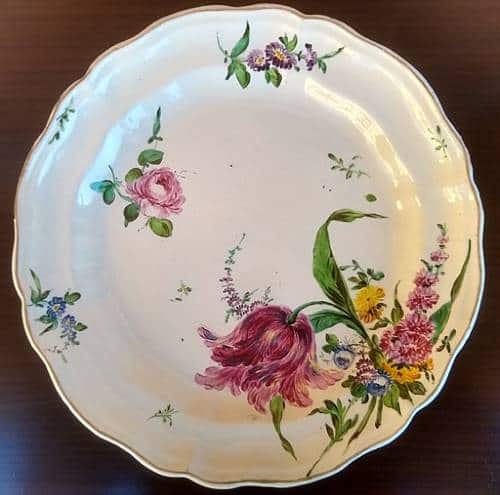
When Italy started to produce and export its own maiolica-style pottery, it was called Faience. Another type of maiolica pottery is called Delft or Delftware. This was developed in Delft in the Netherlands.
It was introduced to Holland by Italian potters who were working there. Like maiolica, it was tin-glazed ware. However much of the design was influenced by Oriental porcelain and has blue decoration on white glaze.
If you’d like to know more about the history of Delftware and the development of this beautiful pottery over time, you can check out my article on Delft pottery here.
Majolica
The term majolica is used in two different ways. It is sometimes used interchangeably with Maiolica. However, it also refers to a type of pottery that was developed in the late 19th century, especially in England.
English majolica often had textures and designs modeled or molded on the surface. Colored glaze was then used to decorate the textured designs. The shiny colored glaze would collect in the textured designs.
Creamware
Creamware is a cream-colored earthenware clay that has been painted with a transparent lead glaze. It was first developed in the 18th Century in Staffordshire in England. It was made from white clay that contained flint to keep it from cracking as it is being fired.
Final Thoughts
The question, ‘What is earthenware made of’ addresses a broad topic. Typically, earthenware is made of low fire clay, that is porous when fired. It is also glazed with an earthenware glaze that tends to be softer. However different earthenware clay bodies are made of various combinations of ingredients. In addition to this, earthenware can be made using different processes. These processes include being made on a potter’s wheel, pressed from a mold, and being slip cast.



